 |
|
|

|
2007
November
29-30
|
Hidden inflation?
It is claimed that there has been hidden inflation since the 1970s —
the real cost of living has gone up a lot more than the CPI shows —
and that's the reason for "the two-income trap" (the necessity of both spouses
working nowadays, whether they want to or not).
See
this discussion.
In 1970, a Chevy Impala cost 6 months' wages, and a house cost 48 months' wages.
Now they cost 9 and 100 months' wages respectively.
Other things that have gone up drastically (measured in work, not dollars)
are health care and in-state college tuition.
Well... Something has happened, but it's not "hidden inflation."
There has also been a massive increase in people's expectations of what a middle-class
standard of living should entail.
A 2007 Chevy Impala is a much better-engineered car than a 1970 one. Most 1970 cars were trash.
The useful life of a modern car is maybe 15 or 20 years, as opposed to 5 or less for a 1970 car.
And a normal middle-class house is bigger than it used to be.
In the 1960s my parents built 1500-square-foot houses, which were considered large
and luxurious. Today they are considered so small that some places won't let you build them!
In-state college tuition is a government fee, not a market commodity. It can be as low or
as high as the state government cares to make it. Personally, I think it should be zero,
but that's just me. It is certainly no measure of inflation.
And health care has undergone such massive technological changes that we're still struggling
to understand their economic effects, but one thing's for sure — we get to live longer.
Who among us would be content with 1970 health care? No coronary stents, no CAT scans...
You probably know a good many people who would not be alive right now if medical technology had not
advanced since 1970.
A rising standard of living is not an evil thing. But the way out of the "two-income trap"
might be to get off the treadmill. Make up your mind that life is not unlivable
in a 1500-square-foot house, with a used car, and so on.
Judge your standard of living by your own level of
comfort and enjoyment, not by whether your toys are as big as somebody else's toys.
The "virtue of contentment" is an old Christian concept that now needs to be applied
to personal finance.
And what about all the things whose cost, measured in labor, went way down since 1970?
A decent-sounding stereo system could cost more than
a month's wages in 1970; it costs maybe three days' wages
today. A 3-minute international phone call cost a whole day's wages in 1970; today, if you find
the best deals, it's almost free. And then there are computers.
Permanent link to this entry


|

|
2007
November
28
|
Comet Holmes, still growing
On the evening of the 27th, I got to see Comet Holmes against a clear, moonless
sky for the first time in a while. It's still there — now about the same
brightness as the central part of M31 but larger in apparent size, a fine sight
in binoculars.
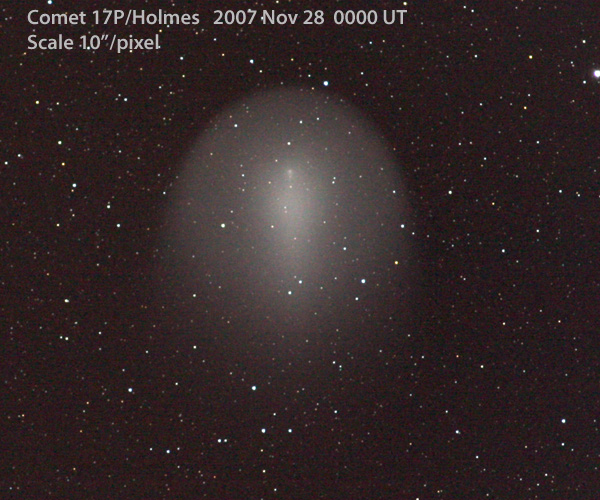
This is an underexposed, grainy image taken in some haste just before the moon rose.
It is to the same scale as
the one taken 8 days ago.
Look how the comet continues to grow!
Permanent link to this entry


|

|
2007
November
26-27
|
Not gone, just busy
I'm busy writing things that are more important, or at least more urgent, than notebook entries.
I'll be back in a few days.
In the meantime, cruise the
Other Vintage Electronics
section on eBay.
It's frightening how many of these things bring back memories...
I must be older than I look.
Permanent link to this entry


|

|
2007
November
25
|
Another one bites the dust
Another USB front-panel card reader didn't work either, although the symptoms
were completely different. This one, a DYNEX unit from Best Buy, didn't disrupt
other USB devices. Instead it operated intermittently; Windows would report "new
hardware found" or hardware disconnected (with accompanying rising and falling
musical notes) every few minutes, and much of the time, it would refuse to read
cards, although occasionally it worked fine.
Conclusion? There's a lot of cheap nonstandard USB hardware on the market now.
The motherboard USB port itself is perfectly OK. I've wired it to a regular USB jack
(which is how I used it until recently), and it works fine with a variety of USB
devices.
Permanent link to this entry
Miscellany
Tube audio: See
this
interesting article published in IEEE Spectrum about a decade ago.
The first Thanksgiving as a triumph of private property over communism:
See this article.
Basically, in 1621 and 1622 the Mayflower Pilgrims did all their farming in common,
and no individual had much of an incentive to work hard,
and they all nearly starved.
In 1623 they adopted a private property system and had their first successful harvest.
Permanent link to this entry


|

|
2007
November
24
|
Making the stars stand out
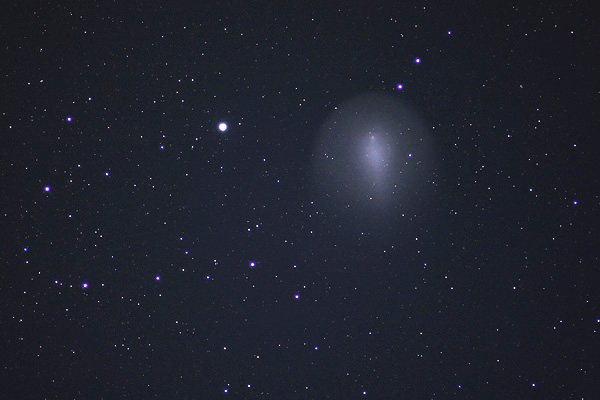
The difference between this comet picture and my earlier ones is that now,
the brighter stars stand out more from the fainter ones.
The trouble with DSLRs is that light doesn't spread sideways in the sensor the way
it does in film; and furthermore, our lenses are sharper than they used to be.
So bright stars don't show up as bigger dots than fainter ones.
I'm trying to overcome this by combining a long-exposure image with a blurred copy
of a short-exposure image that shows only the brightest stars. This fattens up the
brighter stars nicely. I'll say more about this when it's perfected.
Comet Holmes is now a faded object — not visible to the naked eye under moonlit
skies, and somewhat hard to see even in the telescope. The full moon is part of the
problem, of course. Under a dark sky, we would still consider it a fine sight if it
had not been so much brighter recently.
Permanent link to this entry
Shoppers, start your engines...
Having decided to have a scaled-down Christmas, we watched with some amusement as
advertisers tried to whip up a shopping frenzy today.
We did get out to a couple of computer stores for purely utilitarian reasons
(replacing the infamous USB card reader).
General impression?
Bargains were confined to the early morning "doorbuster specials" —
later in the day, prices were higher than normal.
Permanent link to this entry


|

|
2007
November
23
|
Feast!
Cathy did things right, serving us an organically raised turkey that had never
been frozen (and thus came out tender all over), draped in nitrate-free bacon.
The dogs (Babbage and Tycho)
thought it was for them, and we had their undivided attention.
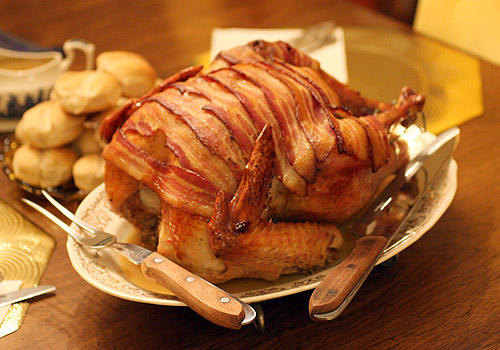
Neither Cathy nor I recommend organic food for everybody all the time
— it would create food
shortages — but it certainly is good.
Permanent link to this entry
Strange USB disruption
My ASUS P4PE motherboard has 3 USB controllers, two connected to the rear panel and one,
inside, heretofore unused.
The other day I bought the cheap memory card reader that you see below and connected it to
the internal USB header. It worked, though I was mildly annoyed by those inane LEDs,
which lit up all the time. Maybe they weren't supposed to — maybe that was a sign of
an electronic failure.

But then my scanner became slow (though generally usable) and my USB-attached printer
(an Epson R300) stopped working. Or rather, to be precise, it would print only part of
a picture and then would only print gibberish.
Removing the card reader cured the problems.
I didn't know a badly designed or defective USB device could disrupt another one
on a different controller. Does it have anything to do with the fact that there
is also a card reader in the Epson printer?
Permanent link to this entry
Where to get some useful things
Information about whether online vendors are reliable:
www.resellerratings.com.
Look up, for example, Best Price Cameras.
Transparent red acrylic plastic for computer screens, to preserve
astronomers' night vision:
Sloan's Wood Shop.
Product 911, transparent red, comes highly recommended.
For the same purpose, don't forget Rubylith (Google the name; it's available lots of places).
Innovative LED lighting for darkrooms and many other purposes:
The Lighting Division.
More old science books on the Internet:
Worthy Science Sources.
Permanent link to this entry


|

|
2007
November
22
(Extra)
|
Thanksgiving
No, the holiday didn't go right past me — I got ahead of myself and put today's date
on material written earlier. So here's the real Notebook entry for Thanksgiving Day,
November 22, 2007.
We have a lot to be thankful for this year:
- Cathy is enjoying her studies at the Lamar Dodd School of Art
and has been accepted into a specialty
(ceramics).
- Sharon is thriving at Oxford College of Emory University.
- Melody has been at her new job nearly a year and has fun
making web pages like this.
- I've started a new line of research
(yes, I know there's not much on that web page yet).
- In rapid succession I've had a book published,
found a great place to see the sky,
observed and photographed a comet ad nauseam, and generally had a lot of fun with astronomy
and other hobbies.
This year's turkey feast is being prepared by Cathy and Sharon. Pictures soon.
Permanent link to this entry


|

|
2007
November
22
|
Recommend an e-mail client?
A request to my loyal readers:
Can someone recommend e-mail client software for me?
I leave my mail on the server and check it from several
different computers. I want each message to stay on the server
until I explicitly delete it.
I'm currently using Mailwasher, which has a marvelous spam filter that I no
longer need since the spam is already filtered.
Also, Mailwasher does not let me view messages in HTML, nor download the attached
files. So if a message contains pictures or files, I have to open it again in
Outlook Express.
Is there a cheap or free mail client that I can use to read and answer mail
(POP protocol) while leaving it on the server, and then delete it on command?
Outlook Express isn't quite right; among other deficiencies, when told to delete
a piece of mail from the server, it doesn't actually do so until you check mail
again. It also doesn't let you preserve the copy in your (local) inbox while deleting the mail
from the server.
Permanent link to this entry
$26 more if you actually want it
I needed a laptop battery today, so I looked it up on
the Batteries Plus web site.
The web page asked for my ZIP code, so I assumed it was looking up local stores.
And I found it, for $98.99.
The web page told me the battery was available at a local store and gave me its address.
So I went to the store. There, it was $125.
I was, to put it mildly, displeased. I was prepared to pay an extra $7 in sales tax, but
not an extra $26 just because it was in the local store!
This kind of tactic makes the local dealer look like he's doing a bait-and-switch, even
though in fact it's inflicted on him by corporate headquarters. Not good.
Permanent link to this entry
News roundup
Normal weather is finally setting in; we're going to have some rain every few days
for the next few weeks. This brings some relief from a drought that has lasted
since the spring, although we're still expecting less rain than usual for
several more months.
Is this the year America scales down Christmas?
Sales statistics from this Friday will tell us.
I've mentioned already
a trend
toward scaling down Christmas — after all, it was
de-Christianized some time ago, and now there's not much left.
I'm in favor of cutting back on the commercialism.
Hyundai's rather disconcerting "Duh!" commercial
(to the tune of O Tännenbaum, which, at least, is not a religious song)
is one example of how people want to laugh at Christmas rather than celebrate it.
Mixed news from the credit card industry:
Chase Bank
has abandoned "universal default," meaning they won't penalize you
for being late with a payment to some other creditor.
But a lesser (and weirder) mind at Washington Mutual has
warned customers
that your interest rates could rise to the "default" (penalty) rate
if the company merely "believes" you're going to miss a payment.
If they actually try that, it could make an interesting lawsuit!
What's wrong here? Credit card companies are able to change the terms of an existing loan
at any time. That shouldn't be. The most important regulation I would impose, if I were in charge,
would be that every existing loan has fixed terms, and changes can only apply to new loans.
Either every purchase or every month's purchases would count as one loan.
The second most important regulation would be an interest rate cap. That would end a lot of nonsense.
Ed Bott gives some worthwhile advice
about how
to fix your relatives' PCs
when you're visiting them over the holidays.
He also reveals that
Windows Vista
activation isn't as evil as people think —
Microsoft has issued some genuinely confusing documentation.
And Microsoft is having to combat a serious problem with counterfeiters.
By this they don't mean hobbyists who install on two test machines from one box.
They mean people overseas who make and sell
millions of copies of a Microsoft install disc.
That's what all this "activation" business is aimed at.
Why did the comet get grainier in my more recent pictures?
Because I'm photographing in strong moonlight, and besides that, the comet is fading.
That means I must raise the contrast more in each picture.
The grain is caused by the camera; the comet itself is still as smooth as ever.
Today (Nov. 22) is the 44th anniversary of the deaths, all on the same day,
of Aldous Huxley,
C. S. Lewis,
and John F. Kennedy.
Permanent link to this entry


|

|
2007
November
21
|
Comet and Alpha Persei again
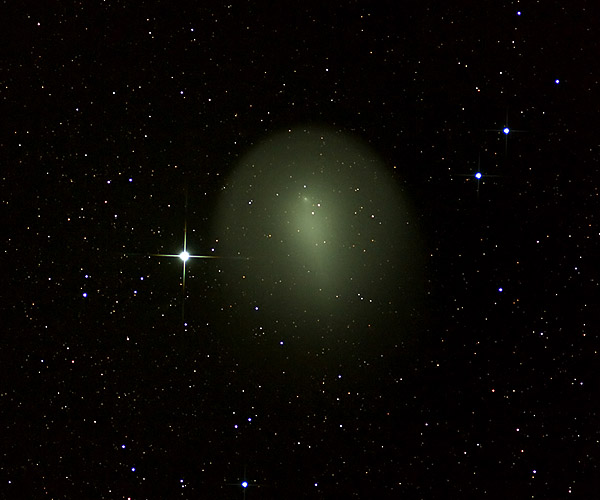
Like yesterday's picture, this one shows the comet at a scale of 10"/pixel,
but the technique was rather different. The 300-mm lens was wide open (to give
a circular aperture with no diffraction spikes) and crosshairs were placed in
front of the lens to create diffraction. The color saturation has been turned
up so that you can see star colors and the greenish-yellow glow of the comet.
Permanent link to this entry


|

|
2007
November
20
|
Christianity and environmentalism
Here's a short essay I originally circulated in response to a call for discussion
from the University of Georgia's
Christian Faculty Forum. Nobody told me I was dead wrong, so here it is for your
perusal also...
I think many evangelicals have been put off by the way secular
environmentalism has presented itself as almost a neo-pagan religion, with
rituals (such as inefficient recycling procedures) and a sense of species
guilt (a vague doctrine of original sin). Steven Landsburg, author of "The
Armchair Economist," flatly declares that environmentalism is a religion to
which he does not adhere.
In real life, environmental stewardship is mostly technology and economics,
and I think one of the biggest principles is that Waste Is Bad. That is, if
you can get more of what you want, while consuming fewer resources, then do
so.
At the risk of sounding a bit like the Council of Trent releasing a list of
anathemas, here are some errors I think we need to explicitly reject:
(1) The notion that exerting effort or suffering discomfort "to save the
earth" is inherently meritorious. What counts is the resources we conserve,
not the discomfort we suffer in order to conserve them. Some recycling
rituals are probably, in toto, a net waste of natural resources (e.g.,
washing out all those bottles individually).
(2) The notion that a high physical standard of living is inherently evil.
Biblically, the richness of the earth and the fruits of technology are ours
to enjoy, as long as the costs don't outweigh the benefits.
In the 1970s we had lots of people objecting to physical comfort (air
conditioning, central heating, etc.) on the ground that anybody who was
comfortable must be greedy. I think this attitude may have reflected a
covetous attitude ("nobody has any business being more comfortable than me")
and partly just atavism ("we didn't need air conditioning in the old days").
(Note that air conditioning has made everyone healthier and more productive
during our hot Southern summers.)
(3) The notion that Homo sapiens, alone among species, has no right to
consume natural resources. (This is, I think, a neo-pagan substitute for
the Christian doctrine of original sin.)
(4) The notion that Homo sapiens is just one species among others.
Biblically and practically, we are the species that is in charge and has
responsibility for the whole earth.
(5) The notion that human sovereignty over the earth is so absolute that we
have a right to destroy its resources for our own use.
(6) The notion that eschatology ("God's plan for the end of the world")
makes it unnecessary for us to conserve our natural environment.
(7) The notion that environmental stewardship is primarily a spiritual or
subjective matter of "getting in harmony with nature." In fact, it is full
of scientific, technical, economic, and political details, including many
genuine controversies.
(8) The notion that anyone who challenges any particular environmentalist
initiative must be anti-stewardship.
I would like to see a real melding of environmentalism with market
economics. Part of the problem with secular environmentalism is that it is
usually politically left-wing and thus doesn't embrace some obvious
possibilities such as taxing pollution — which is something virtually all
economists advocate, and almost no non-economists have even heard of.
Permanent link to this entry
Comet and Alpha Persei
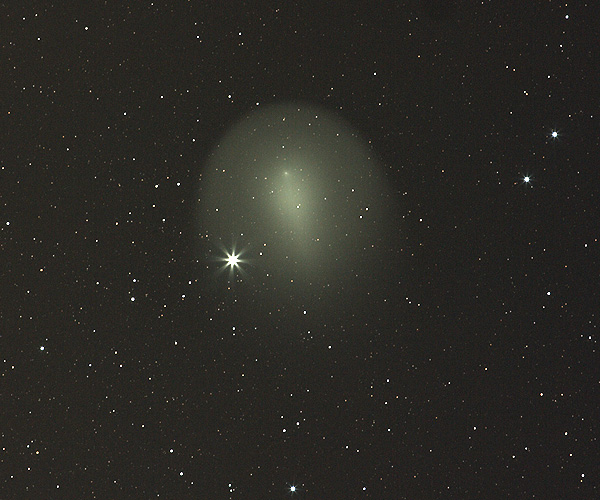
What tonight's picture doesn't show you is that, in addition to being big,
the comet is dim. This picture has a scale of 10 arc-seconds per pixel,
just half the size of the most recent picture below. It's a long exposure; through
the telescope (and in the bright moonlight) I could not see the whole comet, only
the central streak.
Permanent link to this entry


|

|
2007
November
19
|
Evils of the Internet
Why I don't like "social networking":
I think Second Life is one of the worst things to happen to modern popular
culture, and MySpace and Facebook, when used as anything other than
a convenient substitute for conventional web pages, are a close second.
The whole system encourages people to pretend to be what they're not, and to treat others
as objects. Now a girl
has committed suicide after an online "friend" abruptly revealed
he was fake and started taunting her. Other sources tell me that fake, or massively
misrepresented, online friends are an extremely common phenomenon.
Folks, there are always real people on the other end.
I had to hammer this into an earlier generation of Internet users
around 1994 who seemed to feel that newsgroups were a place where it was OK to insult, taunt, bully,
and defraud. At least we're no longer hearing the word "cyberspace" so much — have you
noticed? And it's been 10 years since someone tried to tell me there are no laws in cyberspace —
which is something people did try to tell me, at one time.
Internet fraud alert:
Every few days somebody asks me, "Why are some web sites advertising such-and-such a camera
for $395 when it's $1200 in the stores?"
The answer? Charlatans and thieves.
There are search engines that automatically lead you to the lowest advertised price on an item.
So all a thief has to do is set up a fake store, advertise some popular items, and presto!
Credit card numbers start rolling in.
Word to the wise: Any bozo can have a web site. What ever happened to the notion of looking
for a reliable merchant?
You can probably find some of these con artists right now by searching for
Canon EOS 30D,
a popular camera that ought to cost $800 to $1000 (body only).
Why no law enforcement action here? Who knows? Several consumer groups are tracking down
these rascals, even to the point of publishing pictures of the vacant buildings where they
supposedly conduct business.
You can get camera bargains from Refurbdepot.com,
which sells factory-refurbished merchandise from Canon, Nikon, and other manufacturers.
As of today, the Nikon D40, with zoom lens, is under $500.
Clouded out: Evening 26 with the comet didn't happen. It really is cloudy, with no
breaks in the clouds. (But Middle Georgia is at least getting some much-needed rain.)
Still clear: I'm relieved that the headlight lens restoration that I described yesterday
has held up very well, after a day to dry. I didn't entirely trust it when it was still fresh.
Permanent link to this entry


|

|
2007
November
18
|
Restoring cloudy car headlights
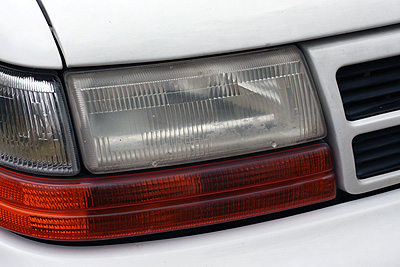
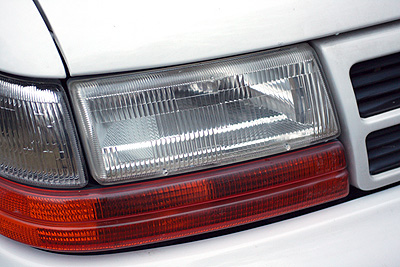
We recently noticed that the headlights on our 1995 Dodge Caravan had become
cloudy and yellowed, to the point that
(to my photographically-trained eyes) it looked as if as much as 2/3 of the light
was being absorbed or scattered.
What had deteriorated was, of course, the plastic lenses in front of the bulbs, not the
bulbs themselves. (This car doesn't have sealed-beam headlights.)
So I bought some
Crystal View Headlight Restorer and
tried it out. I'm glad to report that it works.
You could probably replicate the process, or most of it, without buying Crystal View's
product. Step 1 is to wet-sand each lens for 3 minutes using 1500-grit sandpaper,
keeping it wet with water.
Step 2 is to wet-sand for 1 minute with 2500-grit sandpaper, then dry and inspect the lens.
(It will look very milky.)
At this point you clean the lens with a wet paper towel, and dry it.
Step 3 is to polish for about 1 minute with a cloth pad and a substance that may well be rubbing
compound or some other fine abrasive suspended in a liquid;
I used a buffing wheel on a drill to do a really good job
of this. Then you clean the lens and dry it again.
The last step is to apply a light coat of a milky, sticky liquid that may be acrylic floor wax
or a similar thin acrylic varnish, and let it dry.
And voilà — more light on the road, and less light in oncoming drivers' eyes!
It looks as if the evening of November 17 is completely clouded out, bringing to an end a 24-evening
series of comet observations. No... At 9 p.m. I saw the comet
briefly through a hole in the clouds, using 8x40 binoculars. It is now a dim moon-sized circular patch
nudging against the star Alpha Persei. That's the 25th consecutive evening on which I've observed it.
Permanent link to this entry


|

|
2007
November
17
|
Miscellany
I've been looking at circuit simulation software again and
deciding that I like LTSPICE (SwitcherCAD).
The price is right (free) and good introductory materials are provided,
as well as models of all the ICs made by Linear Technology Corporation
(but hardly anything from anybody else; that's why Linear Technology gives it away free).
It has one uncouth habit, which is that the installer puts the shortcut on the desktop
of the person installing it rather than the All Users desktop.
(Still running Windows 98, are we?)
That's easy to fix manually.
In other news,
if you've ever wondered exactly what goes on inside a zipper,
click
here to find out.
And I've discovered that
I have something in common with Rush Limbaugh,
and it isn't political.
He and I both, as children, had a toy radio transmitter
called a
Remco Caravelle.
Look at the design of the Caravelle's enclosure — I think it's a work of art.
Permanent link to this entry


|

|
2007
November
16
|
The comet fades and grows
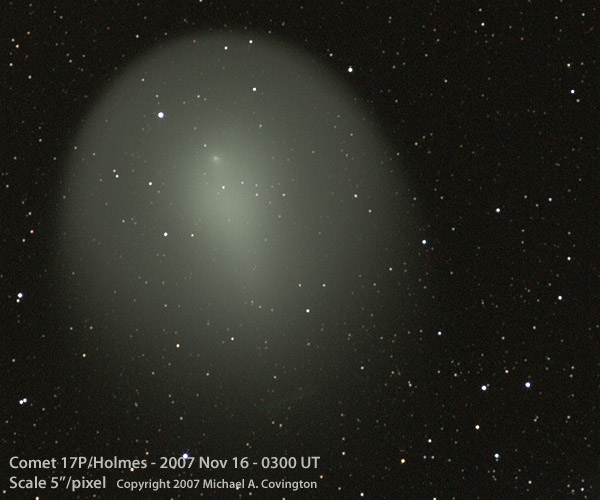
Click on picture for wider-field image
Here's the comet at the same scale as the picture of the moon below.
This is also the last picture I'll be able to give you at a scale of 5 arc-seconds per pixel
because the comet is again outgrowing the picture format.
Permanent link to this entry


|

|
2007
November
15
(Extra)
|
Moon at same scale as comet
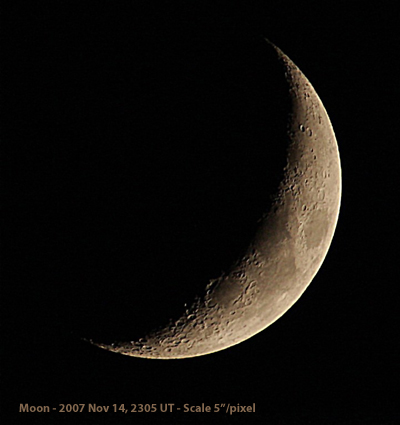
Here's a picture of the moon, taken with the same lens as several recent pictures of the comet
and presented at the same scale. Now you can compare the apparent size of the comet to that
of the moon.
The real size of the comet is larger than the moon, of course, since the comet is much
farther away. The comet is in fact larger than the sun and somewhat farther away.
Permanent link to this entry


|

|
2007
November
15
|
Troubleshooting a slowed-down laptop
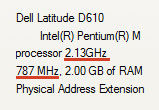 For the last few days, my laptop had seemed slow.
This morning, when I rebooted it, I got the error message,
"The AC power adapter type cannot be determined. This will prevent optimal
system performance."
This is how a Dell laptop tells you there is something wrong with its power supply, or possibly
its motherboard.
For the last few days, my laptop had seemed slow.
This morning, when I rebooted it, I got the error message,
"The AC power adapter type cannot be determined. This will prevent optimal
system performance."
This is how a Dell laptop tells you there is something wrong with its power supply, or possibly
its motherboard.
But how did it "prevent optimal system performance"? Simple.
This laptop has
Intel SpeedStep, a feature I had never noticed before.
SpeedStep slows down the CPU dynamically when it is lightly loaded or running on low batteries.
Right-click on My Computer, check Properties, and if you see two different speeds (as in the
picture), you have SpeedStep. Run something that will put a heavy load on the CPU, such as starting
a virus scan, and do the same thing again. With a heavily loaded CPU, the two speeds should be
the same. If not, SpeedStep is throttling back the speed for some reason.
With its defective AC power adapter, my laptop was slowly running down its battery and had gotten
all the way down to 295 MHz (from 2 GHz, which is 2000 MHz).
Fortunately, it's a University-issued laptop; I just took it to the office, the technician swapped
the AC adapter from another Dell laptop, and Dell is taking it from there.
Permanent link to this entry
Comet report
At 0200 UT on November 15, the comet was distinctly fainter than before, around magnitude 3.0 to 3.5.
I viewed it with binoculars but did not take a picture. Clouds are approaching, and (thank goodness)
we're going to get some rain.
Permanent link to this entry


|

|
2007
November
14
|
Gadget of the day: TI MSP430 target board
Some time ago I mentioned the Texas Instruments
MSP430 starter kit,
which plugs into a USB port and lets you program and debug (trace)
an MSP430 microcontroller on a tiny removable target board.
It sells for $20 including a C compiler.
At the time, my plan was to build an alternative target board with a socket
for DIP MSP430s.
Well, now the Texans have outdone themselves.
For
$10, you can get 3 more target boards
to program with the same gadget.
Each target board has holes (for wires) connected to all 14 pins of the microcontroller.
In essence, the target board is a hybrid IC.
Should I be using the MSP430? I'm not sure. The price is right — about $1.50 for the
14-pin DIP version and, now, $3.33 for the target-board gadget.
It packs a lot more computer power than the PIC or Atmel AVR microcontrollers
that I usually use. It's a 16-bit processor, meaning (at the very least) you're not hampered by
not being able to use numbers larger than 255.
So many computers, so little time! So far I have experience on 8051, PIC (14-bit and down),
68HC11, and AVR microcontrollers. Each involves learning a lot of arbitrary detail which leads
to no particular change in what you really can or can't do.
P.S. Yes, I saw the comet. That makes 21 consecutive nights.
Permanent link to this entry


|

|
2007
November
13
|
Comet Holmes: past its prime?
Here's a picture of Comet Holmes from the 20th consecutive night that I've observed it.
I think the outgassing event is more or less over, so we have a huge, expanding, fading gas cloud
(now the same size in the sky as the full moon)
with a tiny, normal-looking comet in the middle of it
(right below a star in the picture, so it looks like a double star).
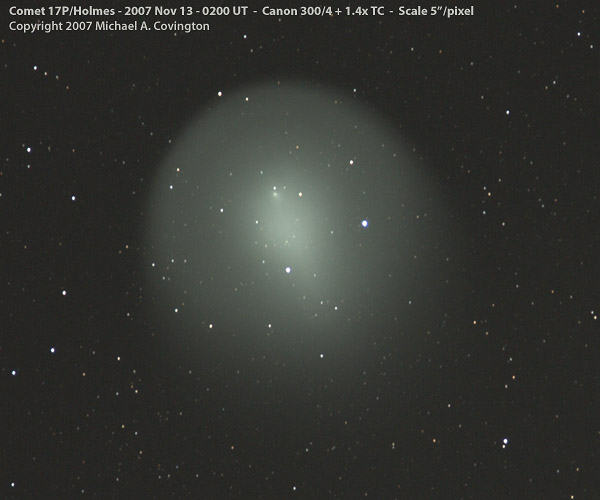
Permanent link to this entry


|

|
2007
November
11-12
|
Miscellany
I saw the comet again on Nov. 10 but didn't photograph it. That's the 18th consecutive night...
From here I could see no major changes, but observers with dark skies have photographed a
tail disconnection event.
That is, the comet has apparently stopped emitting gas, and the tail has separated from it
and drifted away.
I also saw the comet on the evening of Nov. 11, making 19 nights in a row... I only saw it briefly
through a hole in the clouds but was able to estimate its apparent diameter as 0.45 degree
(by comparing to the separations between stars) — that is, it's almost the size of the moon
in the sky.
Is 32.24% usury? That's the new annual percentage rate for holders of FIA (MBNA) credit cards
(including SunTrust MasterCard and Bank of America Visa)
who are late with 2 payments in a 12-month period. Not me.
They're not getting a penny from me because, although I have the cards, I never use them.
One of them is tied
to the overdraft protection on my checking account, and apart from that, their only function is
to pump up my credit score by showing that I have a lot of unused credit.
Word to the wise: Your bank does not operate the credit card with its trademark on it.
It just licenses the use of its name. If I were in charge, that would not be permitted.
Nor would 32-percent interest, even as a penalty.
The default (penalty) rate on Chase credit cards is also 32.24%. Where did they get that number?
As I've said before,
the difference between an honest lender and a usurer, in my opinion, is that if someone is having
trouble paying back the loans, the honest lender stops lending him money, but the usurer gleefully
drives him further into debt in order to collect more interest.
Our legislators are eager to rein in paycheck-advance lenders and car-title lenders;
why not usurers who happen to be big banks?
Life expectancy is the same everywhere:
See Greg Mankiw's blog for evidence that,
when you correct for non-health-related causes of death, the human
life expectancy is the same in all developed countries.
American lives are shortened by automobile wrecks and crime, not lack of health care.
Permanent link to this entry


|

|
2007
November
10
|
Short note
My 16 consecutive evenings of comet photography have ended due to clouds,
but I don't have much else to report.
This has been a very busy week, including the launching of a
new research project about which you'll hear more later.
Update: I did view the comet with binoculars, through a somewhat hazy sky,
around 10 p.m. So that makes 17 consecutive nights of observing, and the weather is favorable
for several more.
Electronics gadgeteers, look at the Super
Probe, an interesting microcontroller project.
Permanent link to this entry


|

|
2007
November
9
|
What the comet pictures don't show
The comet has not only grown, but faded. Notice, in the picture below, how the outer gas shell
is so transparent that stars are practically undimmed when shining through it.
Notice also that the lower right (southwest) half of the comet is quite diffuse; it is no longer
a sharp-edged, pearl-like disc all the way around. In short, it's starting to look like a comet.
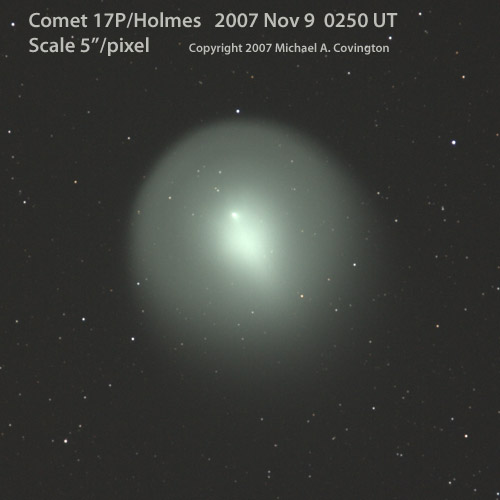
What the pictures don't show is that the comet has faded. The total brightness appears to be
about 1 magnitude below last week's maximum, although this is notoriously hard to judge with a
diffuse object. The comet is enormously larger than before, and thinner. The surface
brightness has declined so much that I'm now using 3-minute exposures; last week I started
with exposures of 1.6 seconds.
Permanent link to this entry


|

|
2007
November
8
|
Comet and nebula
Below is a matched pair of photographs of Comet Holmes and the Orion Nebula to the same scale,
with the same equipment and exposure. This makes it possible to compare their apparent size
and brightness, as well as to see what my favorite nebula looks like in a Canon 40D.
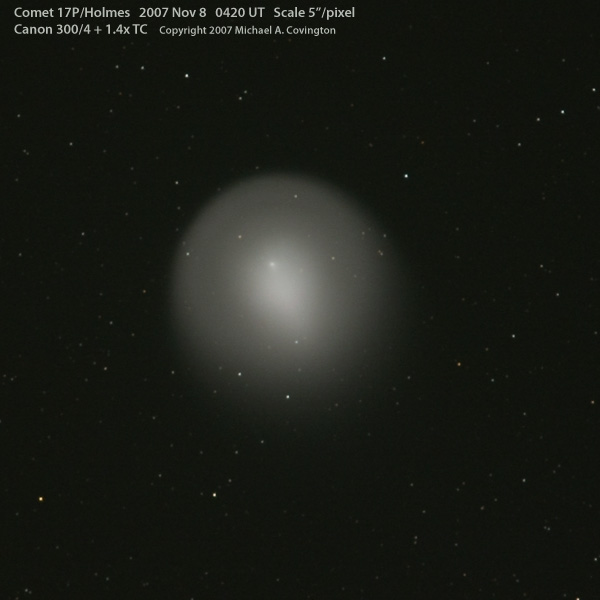
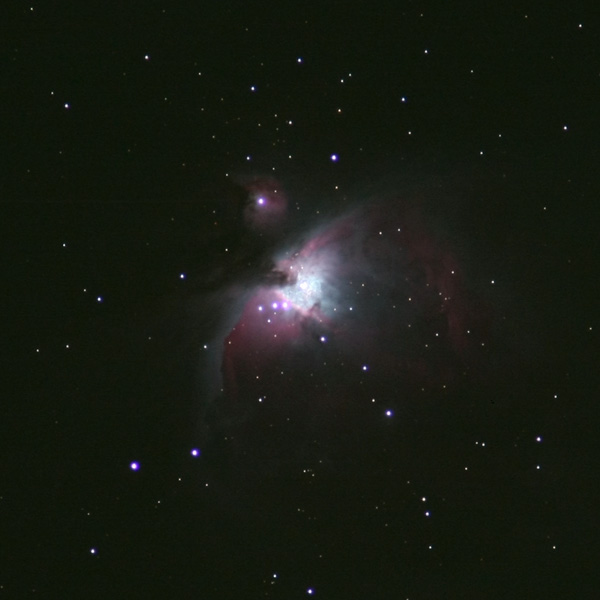
Permanent link to this entry


|

|
2007
November
7
|
Short notes
I did photograph the comet again on the 14th consecutive evening, but it
hadn't changed much. Actually, I wish the drought that is giving us all this clear
weather would end. We're facing a potentially severe water shortage.
Here
and
here
are two pieces by Gregory Mankiw about America's health-insurance (non-)crisis.
He opines that there isn't as big a problem as people say, for several reasons.
"The uninsured" include illegal aliens (who would still be uninsured under any reasonable plan),
people who could buy insurance but don't,
and people who are eligible for Medicaid but haven't actually signed up because they're in good health.
And the main reason we are spending more of our income on health care is that there is more we can buy —
and we shouldn't stop. We don't want to lower our national level of health just to save money, do we?
Who's volunteering to die sooner?
Moreover, some people's health problems are self-inflicted and not due to lack of medical care.
Choice quote from Mankiw: "Whatever its merits, a Canadian-style system of national
health insurance is unlikely to change the sexual mores of American youth."
To this I add that if people were more rational, the AIDS virus would be extinct by now.
Meanwhile, here
is the cleverest microcontroller project I've seen lately.
And here
is something interesting.
Microchip, Inc., has introduced what they call a 32-bit PIC, actually a MIPS-architecture
device.
And the support tools seem to have been born obsolete.
Quoth the starter kit page:
"Note: The PIC32 Starter Kit runs on Microsoft Windows XP and Windows 2000. Support for Windows Vista (32-bit) is planned."
Permanent link to this entry


|

|
2007
November
6
|
I've finally finished processing three weeks' accumulation of
astronomical images. Here are the best...
Comet Holmes: Still growing
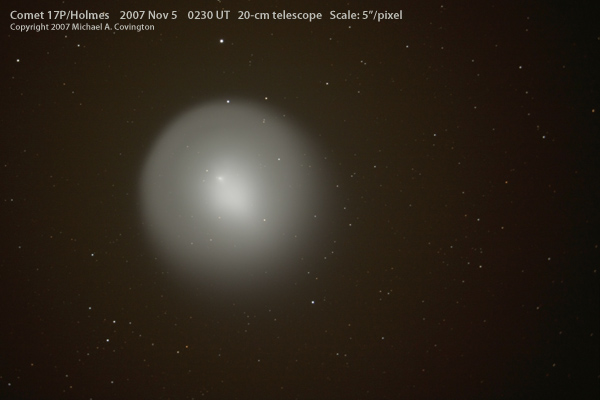
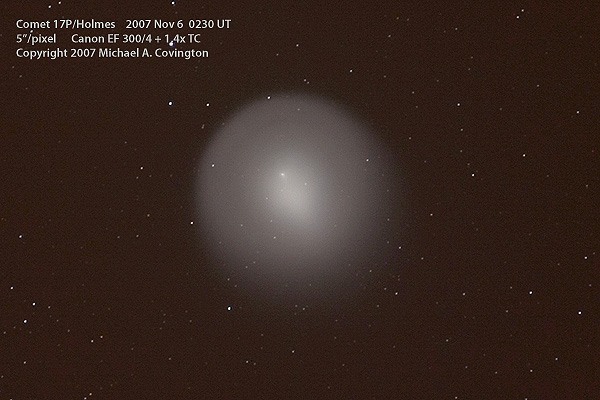
Here you see two pictures Comet Holmes at a scale of 5"/pixel, that is, 2/5 as big as most of the
earlier pictures I've posted. It's outgrowing the telescope I've been using to photograph it,
so although I used the 8-inch telescope on November 5 (UT), I had to switch to a telephoto lens
the next day. Both pictures are scaled to 5"/pixel.
The comet is now over 1000 arc-seconds wide, which is half the apparent size of the full moon.
Of course it is much farther away than the moon. Its physical size is something like ten
times the diameter of Jupiter. It's growing fast!
I've done astrophotography on 13 consecutive nights, which is unprecedented, and there's
no bad weather in sight.
Permanent link to this entry
Pleiades
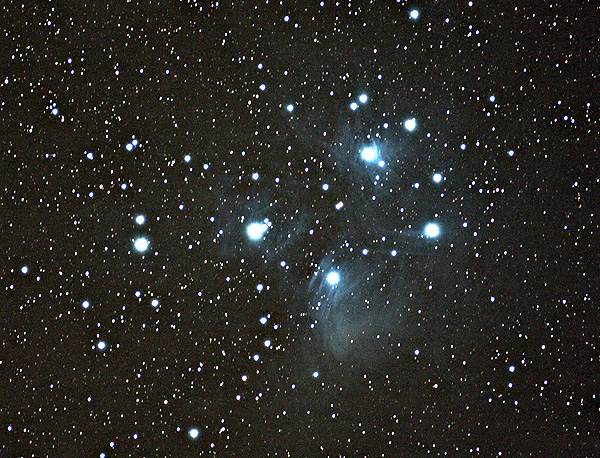
The sky at Deerlick is dark enough to make it easy to photograph the faint
dust clouds around the Pleiades.
This is a stack of 6-minute exposures with the 300-mm f/4 lens piggybacked
on the telescope but not tracking too well.
The dust particles in the clouds are aligned into streaks for mysterious reasons.
This is believed to be a magnetic phenomenon, caused by the magnetic fields
of the stars.
Permanent link to this entry
Merope Nebula
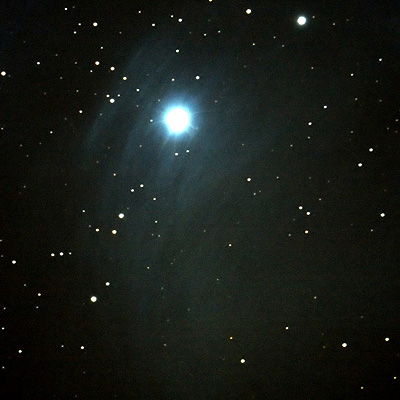
Here is the brightest of those dust clouds through the telescope.
Because of the less favorable f-ratio (f/6.3 instead of f/4), it doesn't
look as bright.
This is a stack of three 6-minute exposures processed with Neat Image to
reduce grain.
Permanent link to this entry
Haunting Helix
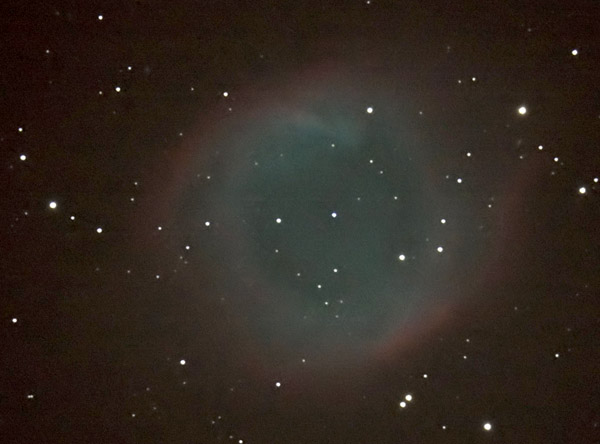
The Helix Nebula is a very faint object, and even this stack of four 6-minute exposures
at f/6.3, ISO 800, didn't produce a very good image of it, although with the
help of MaxIm DL, Photoshop, and Neat Image, I ended up with something presentable.
There is still a slight horizontal streakiness that seems to be inevitable
when severely underexposed images from a Canon 40D are greatly stretched.
(Other 40D owners have reported the same phenomenon.)
I don't know whether the sensor is actually streakier than other models
or whether it's just that the 14-bit ADC brings out irregularities that
would otherwise have been hidden in the noise.
Permanent link to this entry
Dumbbell Nebula (M27)
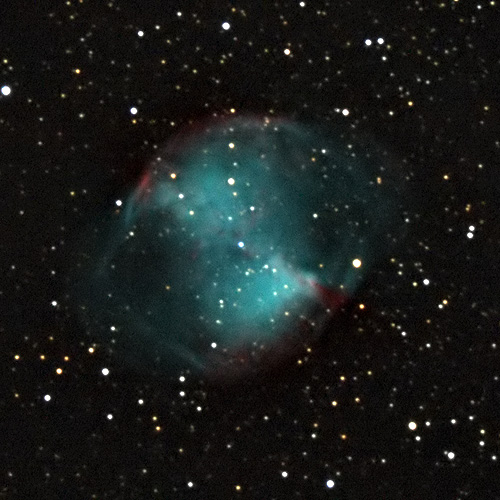
Once thought to be dumbbell-shaped (hence its name), M27 is now thought to be a
structure like the Helix but viewed edge-on, and much denser and brighter.
This is a stack of two 6-minute exposures through the telescope
(8-inch, f/6.3).
Permanent link to this entry
North America Nebula
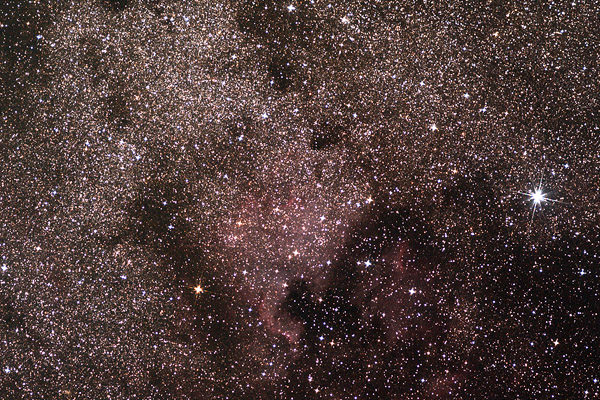
Click for full picture
Here's an old favorite, the North America Nebula, but this picture shows just how clear and
dark the skies of Deerlick are.
Stack of 6-minute exposures with Sigma 105/2.8 DG EX lens at f/4.
Permanent link to this entry
Deer Lick Group of galaxies
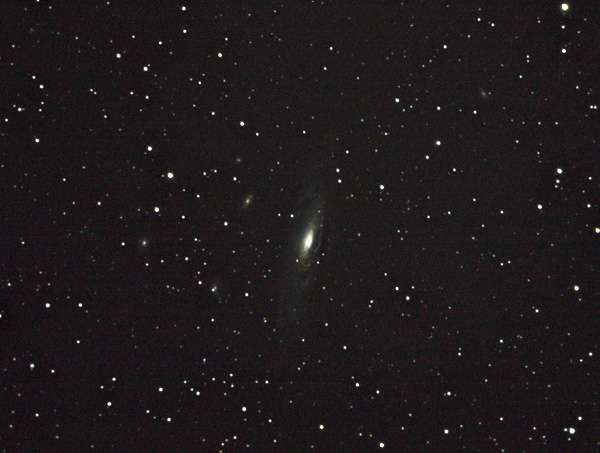
This is the galaxy NGC 7331 in Pegasus together with other galaxies in the field.
Someone (I can't determine who) reportedly
named these the Deer Lick Group
in honor of a successful
night of observing at Deer Lick Gap, North Carolina.
Later, the investors who were going to found Deerlick Astronomy Village
named themselves the Deer Lick Group
after the galaxies. So the Georgia observing site is named
after a group of galaxies that is named after a North Carolina observing site.
(This vaguely reminds me of a Baptist church in Cambridge, England, that is named after a street
that is named after a nearby Anglican church... Almost circular, not quite.)
Naturally, this picture was taken at Deerlick. It is the central portion of a stack of just
two 6-minute exposures through the 8-inch telescope. How many galaxies can you see?
My understanding is that the galaxies do form a group in space; they are not just aligned
along the same line of sight.
Permanent link to this entry


|

|
2007
November
5
|
A tail to tell of
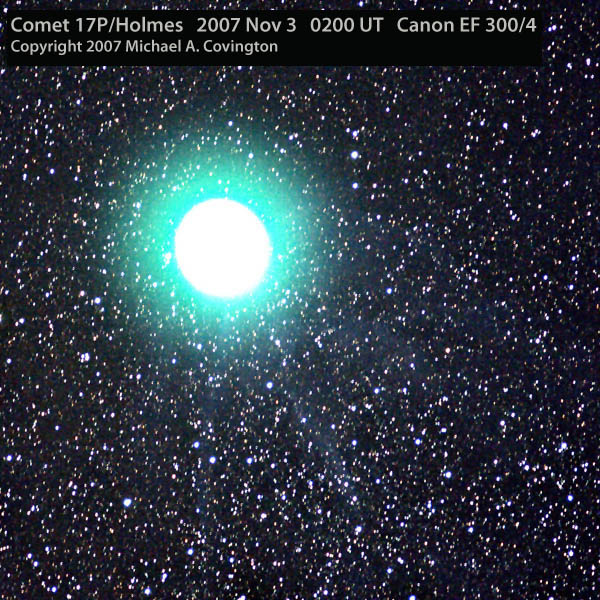
Comet Holmes is growing a tail, or maybe several of them.
This is a stack of 6-minute exposures through a 300-mm lens,
taken at Deerlick on the evening of Nov. 2 (Nov. 3 UT) and greatly contrast-stretched.
Note that this picture is 24 hours older than the one I posted yesterday (scroll down to see it).
Permanent link to this entry
Yuppie trick-or-treating
At least two people wrote to the local paper (and I wasn't one of them) to inveigh against
the modern custom of delivering children by car to neighborhoods where they're going to
trick-or-treat. This is objectionable from two angles: The children cover too large a territory,
and the parents don't keep them company (for safety) while they walk up to the houses.
I think yuppie competitiveness is partly to blame. Apparently the following scene played itself
out in many households this Halloween:
(1) Parents transport children by car to numerous neighborhoods to get as much candy as possible.
(2) Children get too much candy.
(3) Because candy is Not Healthy To Eat, parents take away the excess of candy
which the children could have refrained from collecting in the first place.
Permanent link to this entry
Does changing to and from Daylight Saving Time cost lives?
We knew already that every spring, the change to Daylight Saving Time deprives people of sleep
and causes road accidents.
Now there's evidence
that the opposite change, in the fall, causes car-vs.-pedestrian accidents because
people are not used to walking or driving home in the dark.
And I complain every year that I have to go around and set about 30 clocks.
Gone are the days when there was just one clock in Grandpa's house and it had to be
set every few days anyhow. Today, there are clocks in everything. Some of them even
set themselves to DST automatically on the wrong date (because Congress recently
changed the dates).
Is Daylight Saving Time necessary? Is it really doing us any good?
Or is it just something demanded by lobbyists for the outdoor recreation industry
and, lately (vis-à-vis Halloween and the date change) the candy industry?
Since nobody (or at least, no lobbyist with money) is willing to
get rid of DST, I propose that instead we adopt
year-round Daylight Saving Time, like we had in World War II and again
for a while in the mid-1970s. Back then, evidence was unclear as to its effects
on safety and energy consumption, but
this study
and many others have since shown us that
changing our clocks a whole hour, twice a year, is bad.
Back in the Seventies, year-round DST was ended because schoolchildren in the far north
(where the winter days are especially short)
were having to wait for school buses early in the morning, in the dark.
To which I reply: Maybe you're starting your school day too early.
Maybe you should adapt your own lives to your physical environment
rather than disturbing the rest of the country.
Permanent link to this entry


|

|
2007
November
4
|
Comet 17P/Holmes
OK, here's part of the long-promised surfeit of pictures.
I'm skipping out of chronological order and giving you the Nov. 4 (UT) pictures
before those of the previous day.
The following is positively the last picture of Comet Holmes that I'll be
able to share with you at a scale of 2 arc-seconds per pixel.
As of Nov. 4 (UT), it has outgrown the maximum picture size for this notebook.
From now on, the scale will be smaller, probably 4"/pixel.
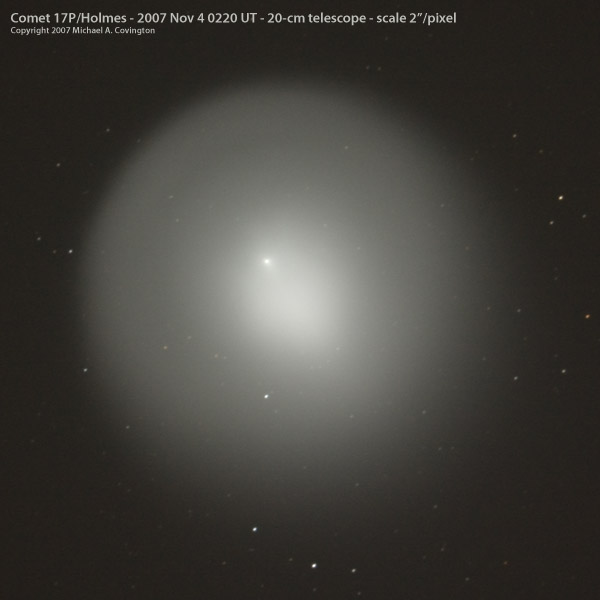
This is a better picture than was originally posted for this entry; I've revised it.
Here you see a stack of three 30-second and one 90-second exposure through the telescope.
Compare to other pictures at the same scale at the bottom of this page.
But what does it look like in the sky? Here's a wide-field view that shows roughly
what you'll see if you look up at Perseus rising, except that the comet looks
disproportionately bright in the picture. In real life it looks comparable to the
brightest nearby stars, not appreciably brighter.
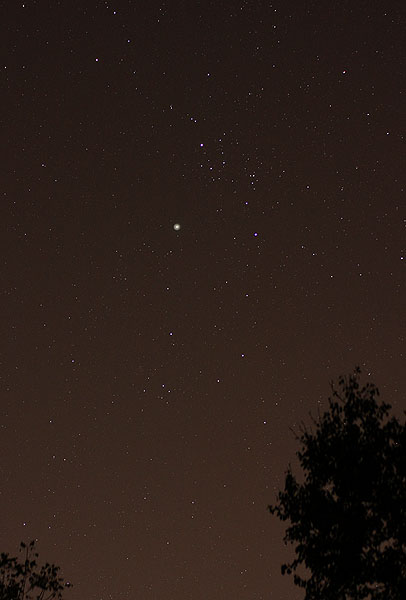
Single 30-second exposure through our new Sigma 50/2.8 macro lens at f/4.
Permanent link to this entry


|

|
2007
November
3
|
Work crunch
Please bear with me while I do lots of things other than write Notebook entries.
(Comet Holmes is very active and I'm about to complete 10 consecutive evenings of
astrophotography. Pictures soon.)
In the meantime:
Here is a very funny video of a cartoon character
struggling with the animation software that created him.
(Click PLAY.) It's Animator vs. Animation, by Alan Becker.
And here
is a handy electronic circuit to run a 4-volt white or blue LED from 1.5 volts.
Permanent link to this entry


|

|
2007
November
2
|
It's a book!
Digital SLR Astrophotography is finally in distribution and the first copies
reached me at 10 a.m. on November 1.
Click here for more.
Permanent link to this entry


|

|
2007
November
1
|
The great round comet of 2007
I've now photographed Comet Holmes on 7 consecutive nights.
Below is tonight's picture, followed by a montage of images from
recent days at the same scale. How it's grown!
The big picture closely mimics the comet's
present appearance in an 8-inch telescope at 100×.
It is a combination of several 30- and 90-second exposures.
This is, I think, the brightest comet since Hale-Bopp and certainly
the only comet I've ever heard of that achieved this brightness without
forming a tail.
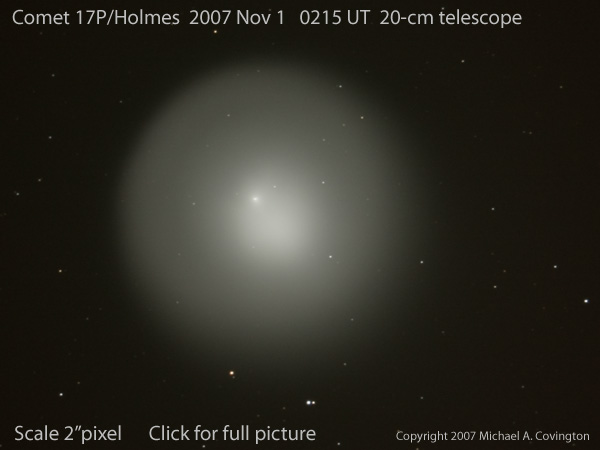
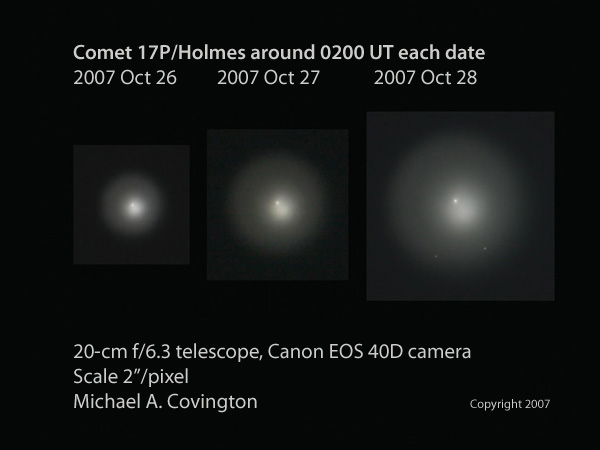
Permanent link to this entry


|

|
| |
Entries are most often uploaded around 0000 UT on the date given,
which is the previous evening in the United States.
| |
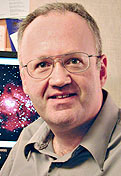

















 For the last few days, my laptop had seemed slow.
This morning, when I rebooted it, I got the error message,
"The AC power adapter type cannot be determined. This will prevent optimal
system performance."
This is how a Dell laptop tells you there is something wrong with its power supply, or possibly
its motherboard.
For the last few days, my laptop had seemed slow.
This morning, when I rebooted it, I got the error message,
"The AC power adapter type cannot be determined. This will prevent optimal
system performance."
This is how a Dell laptop tells you there is something wrong with its power supply, or possibly
its motherboard.
















